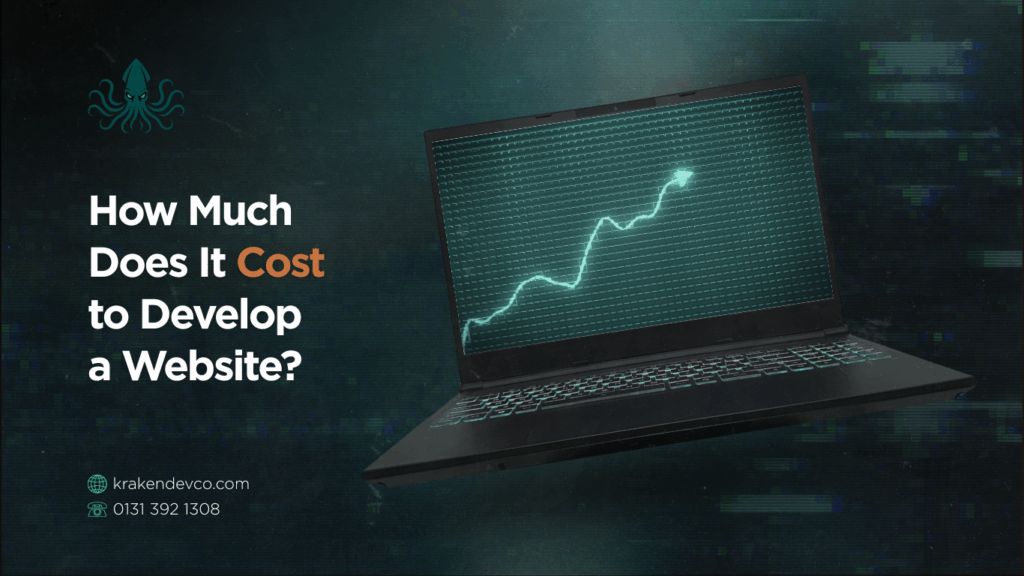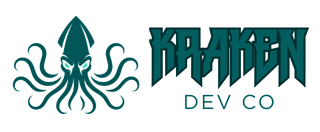
Is your website a digital asset—or just dead weight online?
In 2025, your website isn’t a nice-to-have. It’s your sales engine, credibility checkpoint, lead funnel and storefront—compressed into code. Yet, many businesses still ask, “How much does a website cost?” That’s the wrong question. The right one is: what should you invest to make your website perform?
At Kraken Dev Co, we work with ambitious teams that demand more than a template. This post unpacks the real economics behind modern web development—without fluff. Straight numbers. Real logic. Clear outcomes.
The Fast Answer: Cost Brackets
Let’s break the silence first. Here’s the ballpark you’re stepping into:
- DIY Website Builders: £0–£500/year
- Freelancers: £500–£5,000
- Agencies: £5,000–£145,000+
- Ongoing Maintenance: £150–£15,000/year
These aren’t arbitrary. But they’re not universal either. To budget with purpose, you need to know what drives the price up—or down.
1. Website Type: Your First Cost Driver
Every website serves a business function. Each of those functions comes with a different scope—and a different price tag.
| Type | Purpose | Avg Cost (USD) | Time (hrs) |
| Landing Page | Quick conversions | $5,000 | 80 |
| Blog | SEO-driven content | $7,000 | 120 |
| Corporate Site | Brand presence, trust, contact | $10,000–$20,000 | 160 |
| E-commerce Site | Online store, checkout flows | $60,000 | 1,000 |
| Marketplace | Buyer–seller interactions | $70,000–$130,000 | 1,300 |
| SaaS Platform | App logic, subscriptions | $75,000–$120,000 | 1,200+ |
| Social Network | Roles, real-time interaction | $120,000+ | 2,000+ |
Note: You’re not paying for “pages”—you’re paying for business logic. The more logic, the more build hours.
2. Team: Who You Hire = What You Pay
It’s not just what you build. It’s who builds it. Here’s how different teams stack up, based on ~1,000 hours of work:
- Freelancers: ~$30,000
- Outsourced Agency: ~$40,000
- In-house Team: ~$90,000
- Local Specialist Agency: ~$120,000
Cheaper options usually skip project management, QA, DevOps, and scale-readiness. That’s not a discount—it’s a deferred liability.
Kraken take: The most expensive build is the one you have to redo.
3. Location: The Global Pricing Gap
Your developer’s geography directly hits your invoice.
| Region | Hourly Rate (USD) |
| US | $100–$150 |
| UK | $90–$120 |
| Australia | $80–$120 |
| Western Europe | $70–$100 |
| Ukraine | $40–$80 |
| India | $10–$40 |
You can commission a £60,000-grade site for £20,000 overseas. But if you’re not hands-on with security, QA, and architecture, you’re gambling. High risk. Lower accountability.
4. Complexity Drives Cost
More features = more hours. Simple.
What adds cost?
- Advanced forms and search
- Real-time data
- User accounts, subscriptions
- Admin dashboards
- Payment integrations
- APIs and third-party tools
- Accessibility standards
- Security and compliance
What reduces cost?
- Simple brochure-style layouts
- Off-the-shelf components
- Fewer integrations
5. Timelines vs. Budget
Time is a multiplier. Bigger builds need more hours, more people, more money.
| Complexity | Cost (USD) | Timeline |
| Simple | $5,000–$30,000 | 4–8 weeks |
| Mid-Level | $30,000–$80,000 | 3–6 months |
| Complex | $80,000–$300,000 | 6–12+ months |
Every delay impacts ROI. Launch late, lose leads.
6. Build Methods: DIY vs Templates vs Custom
DIY Builders (e.g., Wix, Squarespace)
- Cost: $1,000–$5,000/year
- Use case: Side projects, MVPs
- Limitations: SEO issues, scaling problems
WordPress Templates
- Cost: $5,000–$20,000
- Use case: Small businesses
- Limitations: Plugin bloat, security holes
Custom Build
- Cost: $30,000–$300,000
- Use case: Growth-driven businesses
- Upside: Speed, security, flexibility
If your site powers your business model, templates won’t cut it.
7. People You Actually Need
No, a “dev” isn’t enough. Real builds need full-stack coverage.
| Role | Cost Range |
| Project Manager | £3k–£20k |
| UX/UI Designer | £5k–£25k |
| Tech Lead | £20k–£30k |
| Frontend Developer | £7k+/month |
| Backend Developer | £7k+/month |
| QA Tester | £5k–£50k |
Skip QA? Expect bugs. Skip PM? Deadlines slip. These aren’t optional—they’re functional.
8. Hidden Costs You’ll Face Anyway
Maintenance
Websites aren’t “done” after launch. Updates, plugin conflicts, backups—all cost time and money.
Budget: 2x dev cost over 2 years.
Marketing
Without traffic, a site is invisible. SEO, PPC, content—plan for it.
Budget: 2–3x dev cost.
Tool Stack
- SEO Tools: Ahrefs/Semrush – $140+/mo
- CRM: HubSpot – $50–$150+/mo
- Email: Mailchimp – $15–$100+/mo
These aren’t “extras”—they’re operational needs.
9. By Business Type: What to Expect
| Business Type | DIY Cost (GBP) | Pro Build (GBP) |
| Portfolio | £150/year | £1,000–£3,000 |
| Restaurant | £200–£400/year | £2,000–£6,000 |
| Trades/Services | £250–£500/year | £2,000–£7,000 |
| Small E-commerce | £300–£600/year | £3,000–£10,000 |
| Large E-commerce | £500+/year | £10,000–£50,000 |
| SaaS / Web Apps | – | £15,000–£100,000+ |
The more mission-critical your site, the more investment makes sense.
10. Real-World Build Comparisons
Dreaming big? Here’s what a clone costs:
- Facebook-style Platform: $50,000–$80,000
- Fiverr-style Marketplace: $50,000–$70,000
- Amazon-grade eCommerce: $150,000+
- Airbnb-style Listing Site: $100,000–$150,000
- Udemy-style LMS: $60,000–$100,000
These aren’t “websites”—they’re systems. Full platforms. Expect full investment.
Final Word: It’s Not About Cost. It’s About ROI.
If you’re asking “how much should I spend?”, flip the question.
Ask:
“What does my site need to deliver—and what’s that worth?”
A £1,000 website that doesn’t convert is overpriced.
A £30,000 website that drives £300k in revenue is a bargain.
Ready to Build Something That Works?
Kraken Dev Co builds websites that sell, scale and support real growth. No fluff. No gimmicks. Just engineered performance from the first line of code.
👉 Talk to Kraken Dev Co
Let’s build a site that earns its place.



